Mahabaleshwar is a small town and a municipal council in Satara district, Maharashtra, India. It is a place of pilgrimage for Hindus because Krishna river has its origin here. The British colonial rulers developed the town as a hill station, and served as the summer capital of Bombay Presidency during the British Raj.

The Alphonso mango is a named mango cultivar that originated in India.

Panchgani, called Paachgani , is a hill station and municipal council in Satara district in Maharashtra, India. Panchgani attracts tourists throughout the year. It is also known for having many residential educational institutions.

Basmati, pronounced ['bɑːsmət̪iː], is a variety of long, slender-grained aromatic rice which is traditionally grown in India, Pakistan, and Nepal. As of 2019, India accounted for 65% of the international trade in basmati rice, while Pakistan accounted for the remaining 35%. Many countries use domestically grown basmati rice crops; however, basmati is geographically exclusive to certain districts of India and Pakistan.

New Zealand wine is produced in several of its distinct winegrowing regions. As an island country in the South Pacific Ocean, New Zealand has a largely maritime climate, although its elongated geography produces considerable regional variation from north to south. Like many other New World wines, New Zealand wine is usually produced and labelled as single varietal wines, or if blended, winemakers list the varietal components on the label. New Zealand is best known for its Marlborough Sauvignon Blanc, and more recently its dense, concentrated Pinot Noir from Marlborough, Martinborough and Central Otago.
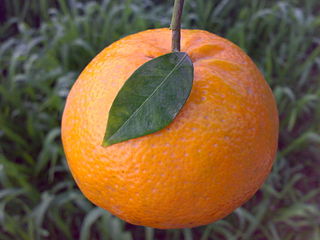
The Kinnow is a high yield mandarin hybrid cultivated extensively in the wider Punjab region of India and Pakistan.
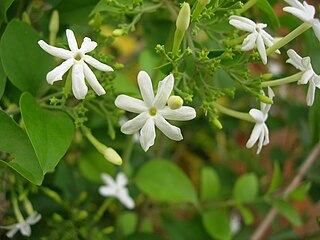
Jasmine is considered the queen of flowers and is called the "Belle of India" or the "Queen of fragrance" as it is exquisitely scented to soothe and refresh. In different parts of India it is called by different names—Mogra, Motia, Chameli, Malli puvvu, Jaati, Mulla, Mallige, Juhi, Mogra or Moonlight in the grove. It is reported that there are 300 varieties of jasmine. It is also stated that jasmine crossed the seas—from Asia to Europe, landing first along the Mediterranean Sea, conquering Greece and Turkey, reaching Western Europe through Spain, then France and Italy and finally landing in England in the latter part of the 17th century..
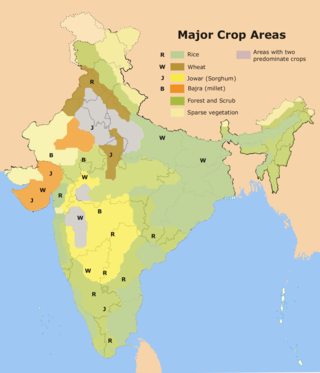
Rice production in India is an important part of the national economy.

Kolhapuri chappals are Indian decorative hand-crafted and braided leather slippers that are locally tanned using vegetable dyes. Kolhapuri Chappals or Kolhapuris as they are commonly referred to are a style of open-toed, T-strap sandal, but also braided leather Mules or braided leather shoe type designs are also common.

Bikaneri bhujia, often simply called bhujia, is a popular crispy snack prepared by using moth bean flour and gram flour and spices, originating from Bikaner, a city in the western state of Rajasthan in India. It is light yellow in colour. Bhujia has become not just a characteristic product of Bikaner, but also a generic name.
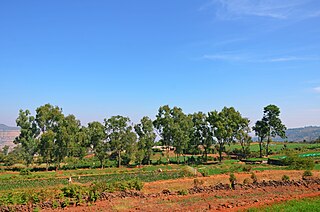
Mapro Gardens is a garden park in the hill station of Panchgani, in the Indian state of Maharashtra. It is near to Mahabaleshwar. The region is India's leading strawberry producer. It is a popular tourist destination. It is located in the village of Gureghar and developed and maintained by food processing company Mapro. Gureghar claims to be one of India's first villages to have 100% sanitation with every house having a biogas plant.

The 'Fazli' mango is a mango cultivar primarily grown in Bangladesh and Indian state of West Bengal. It is a late maturing fruit, available after other varieties. Fazlis are commonly used in jams and pickles in the cuisine of the Indian subcontinent. Each mango can be quite large, going up to a kilo. Rajshahi Division in Bangladesh is the major producers of fazli. An important commercial variety, it is increasingly being exported.

Coorg orange, also called Coorg mandarin, is a cultivar of orange from Kodagu in Karnataka. It was given the Geographical Indication status in 2006.
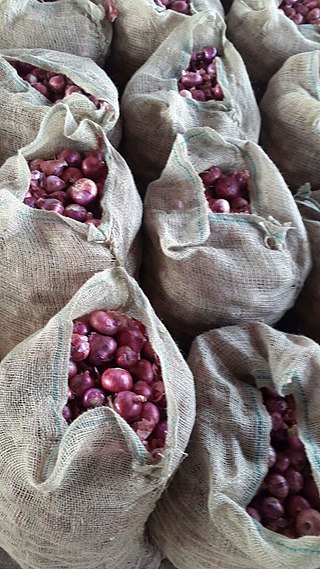
Bangalore rose onion, locally called gulabi eerulli, is a variety of onion grown in and around Bangalore in Karnataka. It got the Geographical Indication tag in 2015.

Kangra tea is a tea from the Kangra district in Himachal Pradesh, India. Both black tea and green tea have been produced in the Kangra Valley since the mid-19th century. Kangra tea was given the Geographical Indication status in 2005.

Nashik grape is a variety of grape produced in Nashik district, which is known as the "grape capital of India". Nashik contributes to more than half of the total grape export from the country.

The Devanahalli pomelo is a variety of the citrus fruit pomelo of the family Rutaceae. It is exclusively grown in the region around Devanahalli taluk, Bangalore Rural District, India, as an exotic crop variety. Its officially designated name is "Devanahalli Pomello (Chakkota)"; it is locally known as chakkota.
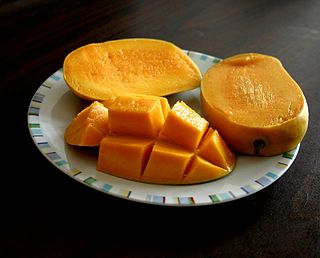
The 'Gir Kesar' mango, also called Kesar, is a mango cultivar grown in the foothills of Girnar in Gujarat, western India. The mango is known for its bright orange colored pulp and was given the geographical indication status in 2011. The biggest market of Gir Kesar is in Talala Gir known as a Mango Market Yard.

Nashik valley wines are specially protected under the patent of the Geographical Indication in India for the region of Nashik district in Maharashtra, India, where it is produced from several vineyards and the Sula wine is one of the major producer of Wines in Nashik. The wine is produced in two types: red and white. The district has 52 wineries in operation and consequently Nashik is occasionally known by the epithet "The Wine Capital of India".
Firiki Piliou is a variety of miniature apples of the species Malus domestica Borkh, protected under a Protected Designation of Origin from Greece.



















